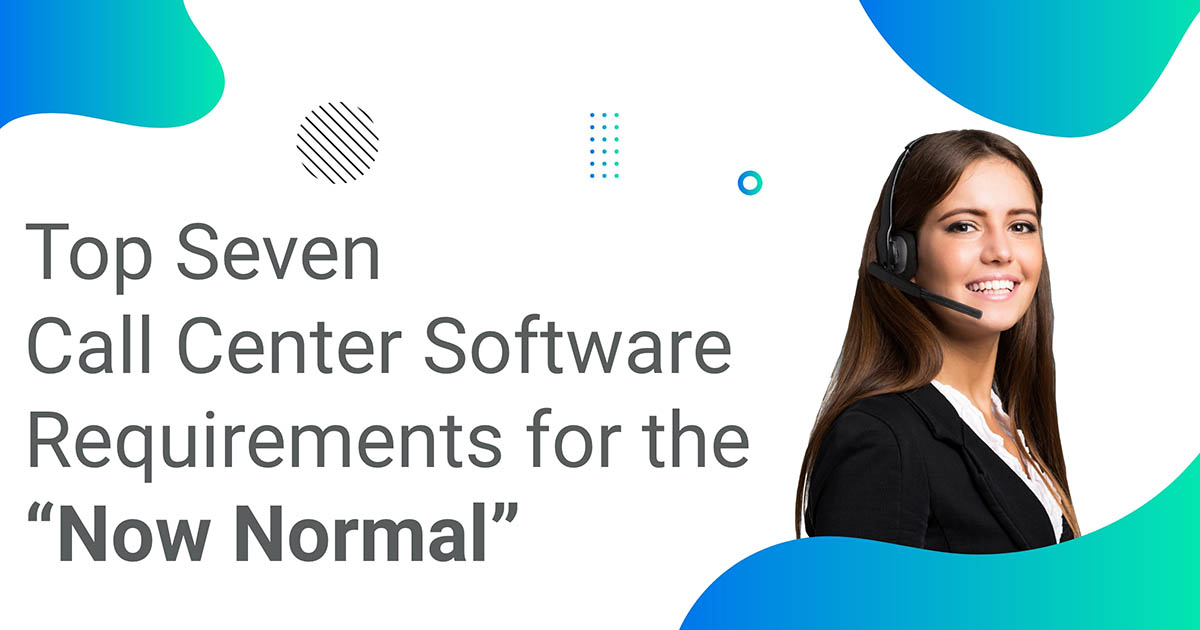Top Seven Call Center Software Requirements for the “New Normal”
COVID-19 had a profound impact on contact centers. Call volumes increased dramatically, staffing levels dipped, and agents had to deal with a sudden and prolonged adjustment to work from home. This blog focuses on delivering quality customer experiences, how call center employees work, the best call center software for small businesses to grow their business, and how digital channels can support the increase in call center volumes.
Here are the top 7 software requirements for call centers for the “New Normal”
In the light of COVID-19, businesses must rethink their customer service strategies. Organizations of all sizes need to act with unprecedented speed to serve their customers and treat their employees with compassion. Businesses must rethink how they can leverage the call center software to enhance the customer experience in the ‘new normal´.
One has witnessed that small businesses are more vulnerable to changes. They must make use of call center software as well as digital channels to increase customer satisfaction while reducing the cost and resolve the challenges customers and agents are facing today.
As companies look beyond the pandemic, automation would make a huge difference, but one thing remains certain, that is the companies are more inclined to remote support than earlier.
Here are seven ways the call centers can thrive in the new normal.
1. Hybrid Working
It is likely that the workplace in the coming days will be a hybrid mixture of remote and office work. In a hybrid work model, employees can work both in-office and remotely. The flexibility to work from home and to come into the office is available to employees. Companies can develop hybrid models based on their and the employee’s needs. Through this way, they get to keep the office space and accommodate both in-person and remote workers, making it an easy solution to the post-covid issues. Businesses must prioritize online communication to get the most out of a hybrid workspace.
Working from home may be one of the best ways to avoid workplace transmission, but these are only successful if they are supported by the right technology. To ensure a consistent workforce experience, companies must establish a work-from-home environment including secure laptops, connectivity, and software licensing. Along with this, they should also optimize call routing configurations to ensure end-to-end security and update all information about the problems the customers face on a daily basis.
2. Data analytics
As COVID-19 transitory phase begins, companies should utilize their data to better predict the needs of their internal workforce and customers. In such volatile times, call centers can meet customer demand most effectively by combining this with one of the most agile methods of managing work and the workforce with the help of the best call center software. The use of predictive analytics will make it possible for operations teams to match work with the available people.
You can create flexible workforce planning, modify IVR features and messaging, and adjust the prioritization and distribution logic on existing platforms with analytics. This also enables less urgent but important calls to be handled first, with the help of call assistants.
3. Automation Services
For companies with established virtual agent programs, scaling up support is critical. Optimize existing virtual agent environments with prioritized intents, 24/7 activation, and routing based on urgency. When it comes to providing the most valuable customer service, human agents must be available for the most complex and valuable needs, while automation can handle everything else. Deploying top call center software can be useful for the public sector. By defining new intents, building upon existing solutions, and leveraging existing solutions, you can make information relevant to today’s rapidly changing global situation.
4. Integrations
The ability to track performance is crucial for determining where to allocate resources for staffing, training, and other initiatives. The first-call resolution rate, average wait time, and abandonment rate are among the most significant metrics to monitor. Today, however, customer experience means much more than just these metrics. Despite the importance of evaluating performance using these traditional KPIs, the next generation of workforce engagement management tools will allow you to focus on aspects such as increasing consumer trust and making sure agents use empathy appropriately.
Also Read: ABC of Virtual Call Center Software and Contact Center
5. SIP Trunk Technology
Choosing the right SIP trunking provider helps you provide your customers with both inbound and outbound mobile and landline calling options, no matter where they work. In order to do this, your provider should be your liaison to public telecommunications services and allow you to do two key things:
- The international dial-in number should be provided to all call participants, regardless of the location, all call participants should be able to join a conference call by dialing the number specific to their region.
- Reach any public switched telephone network (PSTN) number and add the recipient to the conference – call participants should be able to reach any PSTN number and add the recipient to the conference.
Employees and companies will rely more and more on remote workers to get things done in the coming months. By working with a SIP trunking provider that offers high call quality at a reasonable price, your company can meet the customer expectations and overcome them.
6. WebRTC
Companies can now provide a seamless customer experience to users with WebRTC and no download requirement. It is no longer necessary to verify whether the software or application is properly installed, that its version is current, or to wait for the customer to access a service portal to download the needed software, in order to begin communicating with them. With WebRTC, you can launch the web browser and connect via video in just one click.
A WebRTC call can also be converted to a video call with a single click on smartphones. This helps to increase engagement and reassure the customer.
7. Security
A new technology platform and digital systems are required to manage and monitor a distributed workforce and to replace in-person management techniques. It is difficult to manage your virtual employees’ information flow without a messaging center and special routing capabilities. Providing seamless access requires your IT application to allow users to log in to the various tools used by agents, such as identification verification, client and administrative tools, such as scheduling. The use of a virtual meeting platform is important to support team collaboration via multiple chat rooms, large group meetings, and agent-supervisor interaction.
In response to this crisis, the customer experience is likely to get better in various aspects such as agent agility, channel choice, real-time workforce management, and the prevalence of AI virtual agents. Even though experts don’t know how long it will take to contain the virus, businesses must prepare for the short-term, and develop new capabilities and ways of working that could seamlessly for longer-term operational changes.



